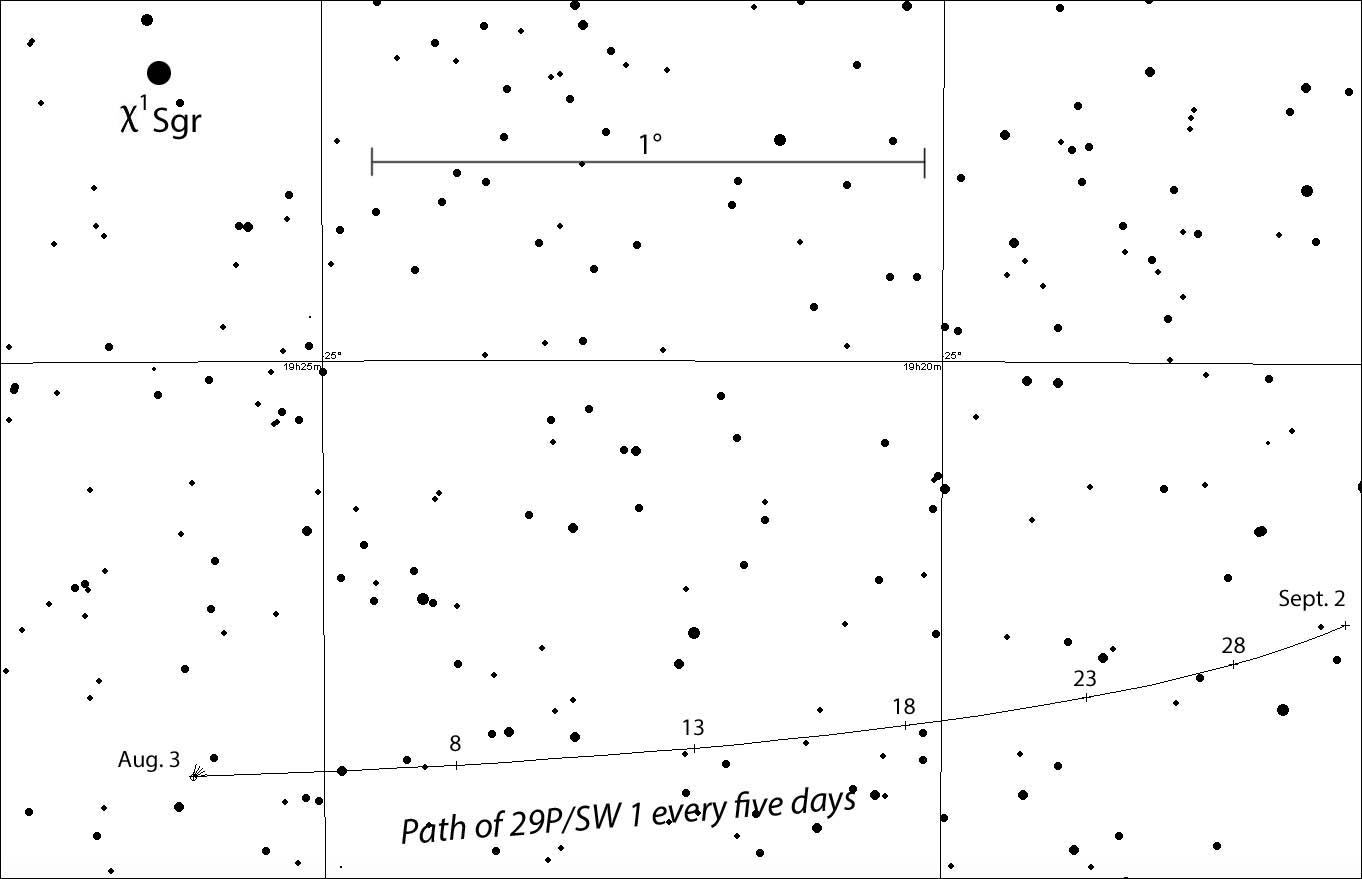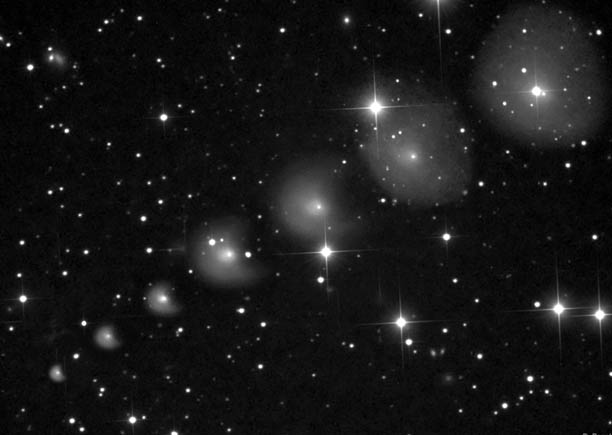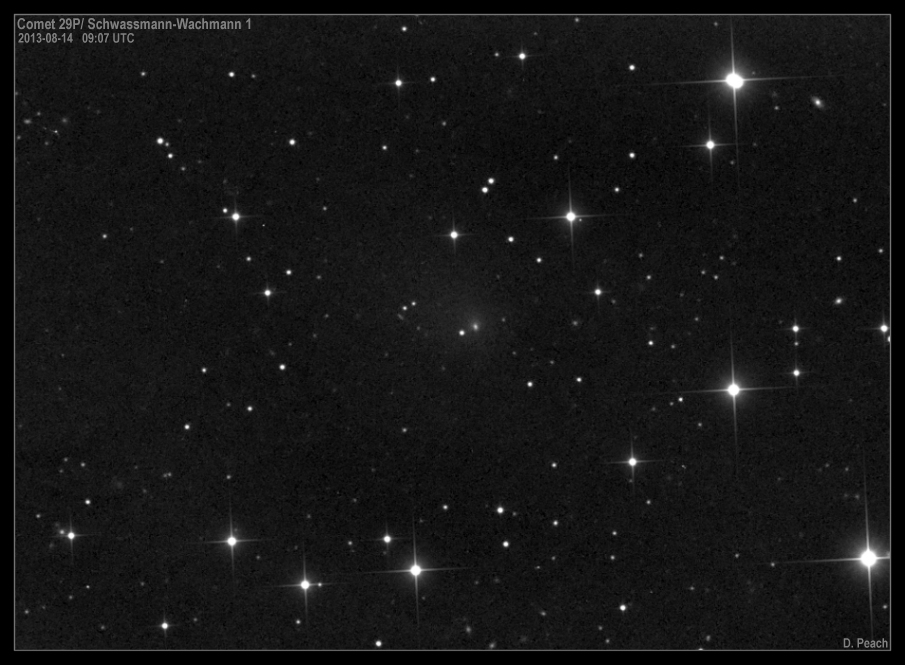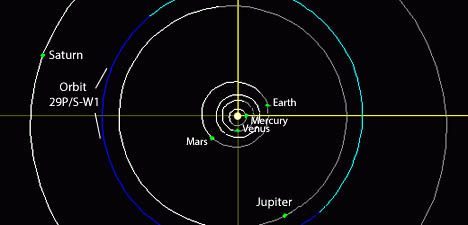.
Comet 29P/Schwassmann-Wachmann 1 has gone into outburst again, wracked by yet another eruption of gas and dust. See it while you can!

Comet 29P/Schwassmann-Wachmann 1 exhibits its classic lopsided coma on July 31 during its most recent outburst. Discovered photographically in 1927 by German astronomers Arnold Schwassmann and Arno Arthur Wachmann, 29P is the most active periodic comet known.
Pepe Manteca
Most comets come and go with a regular period or appear unannounced from the Solar System's cryogenic freezer, the Oort Cloud. Not 29P/Schwassmann-Wachmann 1. This strange and remote object with the throat-clearing name is normally visible for at least a few weeks every year in amateur telescopes when it undergoes an outburst and skyrockets in brightness. This happens not just once a year but 6-7 times on average!
On July 28th, French comet observer Jean-Francois Soulier photographed yet another 29P eruption. Prior to his discovery, the comet had slumbered in eastern Sagittarius around magnitude 15 with a dilute coma and faint nucleus. But overnight it surged to magnitude 12.8, the coma thickened and its false nucleus intensified. From a faint, weak fuzz, the comet briefly assumed a near-stellar appearance.
Through my 15-inch reflector one night later (July 28th-29th), I saw a dense fuzzy spot not unlike a planetary nebula or a star smeared by atmospheric turbulence. Upping the magnification to 224x to get a better look, I estimated the coma to be a mere 15″ across with a bright but indistinct nucleus.

29P slowly ambles west in Sagittarius at –25.5° declination over the next month. The comet's position is shown every 5 days at 11 p.m. CDT with stars plotted to about magnitude +13. North is up. Click to enlarge, save and print out for use at the telescope.
Chris Marriott's SkyMap
Though the comet has continued to expand and slowly fade, 29P still glows at 13th magnitude and remains a fine target for telescopes 10 inches or larger. You'll find it using the included map about 1° south of Chi-1 and Chi-3 Sagittarii, a pair of 5th magnitude stars east of the Teapot's handle. The comet tracks westward in retrograde motion through much of August. Despite its low declination I wouldn't rate it as too difficult a catch even from the northern U.S., the Canadian border and central Europe, as long as you're observing under a dark sky.
Comet 29P swings around the Sun once every 14.6 years in a nearly circular orbit, its distance ranging from 5.7 to 6.2 a.u., or just beyond the orbit of Jupiter. Even though it's a comet, its orbit also makes it a member of a special class of objects called Centaurs. Only about 80 are known. Centaurs cycle round the Sun between Jupiter and Neptune and have unstable orbits; they're thought to be relatively recent escapees from the Kuiper Belt.
How a Faraway Comet Gets Bright
Rarely do comets beyond Jupiter flare brightly enough to detect in amateur telescopes, but 29P can vault to 9th magnitude during its brightest outbursts — a 10,000-fold increase in light! — making it an easy target for scopes as small as 6-inches.

This composite photo shows the fascinating evolution of a 29P flare-up from June 16, 2013 (lower left) to July 28th. The comet's coma often displays a characteristic horseshoe or spiral shape early on as we view the outburst side-on across one hemisphere only.
Damian Peach
Comet nuclei are composed primarily of ices including water, carbon dioxide, carbon monoxide, methane and ammonia mixed with fine silicate and carbon-rich dust. When a comet swings within 3 to 4 a.u. of the Sun, water from vaporizing (sublimating) ice is the primarily volatile carrying off dust to form the coma and tail. At 29P's bone-chilling distance, though, water ice is virtually inert. Instead, vaporizing carbon monoxide (CO) ice appears to be the key driver in its regular outbursts. A variety of different radio telescopes have detected the gas in 29P's coma during its frequent flare-ups.

A spectacular jet, photographed by ESA's Rosetta spacecraft, blasts from Comet 67P/Churyumov-Gerasimenko on July 29, 2015. It enriched the coma with carbon dioxide, methane, hydrogen sulfide as well as organic materials likely related to dust released.
ESA/Rosetta/MPS for OSIRIS Team MPS/UPD/LAM/IAA/SSO/INTA/UPM/DASP/IDA
Since the freezing point of CO is –337°F (–205°C), it readily vaporizes from solar heating at the comet's distance. Although the cause of comet outbursts remains an inexact science, it's thought that subsurface ice, in this case carbon monoxide, is warmed by the Sun and vaporizes.
Now under pressure, the gas seeks a way to the surface through cracks and vents. When it finds an escape route, it blasts into space like a geyser, carrying dust and debris along for the ride. Pits and collapse cavities on the comet's surface may also provide convenient exits for cometary gases.
Under constant attack by solar heating from above and below, comets can develop cracks and cavities that expose even more fresh ice, leading to continued episodes of sublimation and outburst.
Like Lake Superior in the wintertime, this comet's gotta lotta ice. Recent measurements by NASA's Spitzer Space Telescope give a diameter of 37 miles (60 km) for the nucleus, making 29P one of the largest comets known. Perhaps a bountiful supply of material coupled with its nearly constant distance from the Sun act to keep 29P active throughout its orbit. Whatever the cause, amateurs are grateful for 29P's fitful behavior. Its followers get to witness firsthand the essentially chaotic and unpredictable nature of comets — every year!

Comet 29P returned to quiescence by mid-August after the summer 2013 outburst. A recent study has determined the nucleus rotates once every 12 days.
Damian Peach
I caught my first flare-up in the early 1980s. Like avid marathon runners who try to hit marathons in every state, I make it a point to catch at least an outburst a year. I haven't missed one yet thanks to the great observers and astrophotographers who share their images and observations on the Comet Mailing List. If you routinely observe the comet every time you're out with the telescope, you might even be the first to report the next eruption.
As described earlier, Comet 29P has an unstable orbit. One day in the distant future, perturbations from Jupiter may nudge it into the inner Solar System, where its cornucopia of sublimating ice and dust should transform it into a cometary spectacle!
Quelle: Sky&Telescope

